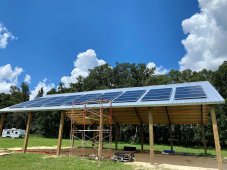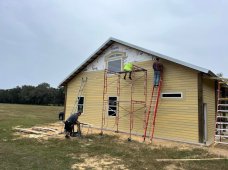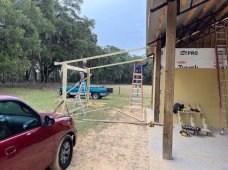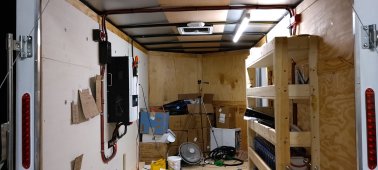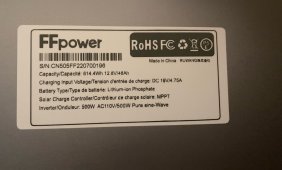I'm hoping the AIO becomes master and the charger slave so the charger has to follow the aio settings.OK ... So a new 48120 is on the way. I hope to be able to fully test it (and the whole system) with the full array in the next month or less.
Thanks
I do use the Calibration Tool from Ian.
But to be clear, If I connect the SCC to AIO via Cat5 and set the settings in the SCC to those above, the SCC charger will "follow" the settings of the AIO ... or at least stop charge when the AIO stops charge? IF that is the case, that will be perfect.
You are using an out of date browser. It may not display this or other websites correctly.
You should upgrade or use an alternative browser.
You should upgrade or use an alternative browser.
Runaway Voltage ~ Growatt SC48120-MPV SCC
- Thread starter MrM1
- Start date
shopman
Solar Enthusiast
I wish I could answer that with an affirmative 'yes' but I haven't had the chance to see the setup fully charge the batteries due to the time of year. Clouds, short days and my neighbors trees are working against me. We're set for several days of sunshine through Christmas so I'm hoping to finally be able to see the system do its thing. During some cloud lens events last week I did see the SCC change its maximum charging rate so I'm pretty sure it was the AIO that commanded the change. I'll post an update when we finally get a full charge.OK ... So a new 48120 is on the way. I hope to be able to fully test it (and the whole system) with the full array in the next month or less.
Thanks
I do use the Calibration Tool from Ian.
But to be clear, If I connect the SCC to AIO via Cat5 and set the settings in the SCC to those above, the SCC charger will "follow" the settings of the AIO ... or at least stop charge when the AIO stops charge? IF that is the case, that will be perfect.
shopman
Solar Enthusiast
Ok. The other night I used the grid to fully charge the batteries before calling it a night. We ran on the inverter overnight and let the sun charge us back up in the morning. Inverter 1 is the AIO, inverter 2 is the SCC that's slaved to the AIO via RS485. As you can see in the graph, the SCC did exactly what it was commanded to do via the AIO. In fact, once the batteries were charged and in float, the AIO never commanded the SCC to start up again since it wasn't needed. I'd call that pretty flawless operation. Despite some peoples opinions, the Growatt stuff is fairly well engineered and works quite well once it's understood. Do be sure to program the SCC to match your charge parameters in the AIO and you should get the same results. I am running the latest firmware from Growatt in the AIO(SPF8000t DVM MPV) in case you're interested. I flashed my unit to correct the occasional non-startup of the MPPT's in the morning, which the flash fixed along with some other annoyances. So far, I'm impressed with this system. Combined with Solar Assistant, it seems to be the perfect(cost effective) solution.OK ... So a new 48120 is on the way. I hope to be able to fully test it (and the whole system) with the full array in the next month or less.
Thanks
I do use the Calibration Tool from Ian.
But to be clear, If I connect the SCC to AIO via Cat5 and set the settings in the SCC to those above, the SCC charger will "follow" the settings of the AIO ... or at least stop charge when the AIO stops charge? IF that is the case, that will be perfect.

MrM1
I'm Here, But I'm Not All There
MrM1
I'm Here, But I'm Not All There
If the aio and scc are communicating and the aio is master, what difference does it make if the charge parameters of the sccc are the same as the aio? The aio should be controlling the scc.Ok. The other night I used the grid to fully charge the batteries before calling it a night. We ran on the inverter overnight and let the sun charge us back up in the morning. Inverter 1 is the AIO, inverter 2 is the SCC that's slaved to the AIO via RS485. As you can see in the graph, the SCC did exactly what it was commanded to do via the AIO. In fact, once the batteries were charged and in float, the AIO never commanded the SCC to start up again since it wasn't needed. I'd call that pretty flawless operation. Despite some peoples opinions, the Growatt stuff is fairly well engineered and works quite well once it's understood. Do be sure to program the SCC to match your charge parameters in the AIO and you should get the same results. I am running the latest firmware from Growatt in the AIO(SPF8000t DVM MPV) in case you're interested. I flashed my unit to correct the occasional non-startup of the MPPT's in the morning, which the flash fixed along with some other annoyances. So far, I'm impressed with this system. Combined with Solar Assistant, it seems to be the perfect(cost effective) solution.
FF Power CH 505 BIBENE
New Member
- Joined
- Dec 22, 2022
- Messages
- 3
I am after purchasing the FF Power 614Wh Portable Power Station CN505, basically it's identical to the BIBENE/Oukitel portable solar power station. I have a question, I am somewhat unfamiliar with solar. I have seen another review where people have purchased a 100 Watt solar panel to charge the station. I am OK with that, my question is about the “ Open Circuit Voltage “ does it have to be between the 12 Volt and 24 Volt which is stated on the front of the device at the DC input port, where I plug in the provided wall charger.
I have seen some 100 Watt solar panels that advertise higher voltages, 24.7 Volts etc. My concern is using a oversized/larger panel than is needed, potentially causing damage to the device .
The device does not provide the “open circuit voltage” or “ max PV input voltage” information in either the owners manual or on the attached sticker on the device. The sticker on the device states ” Charging Input Voltage DC 19V/4.75 A.” . The manual states under inputs, 100W MAX.
I would assume that I could not exceed the 4.7 amps no matter what, that this would potentially damage the device.
Please clarify:
If I put a 100 Watt solar panel in SERIES with another 100 Watt panel, I will double the voltage output ?
If I put a 100 Watt solar panel in PARALLEL with another 100 Watt panel, I will double the AMP output ?
Could someone please provide a an explanation/description of the word Nominal when used in relation to battery voltage.
Any suggestions are welcome. Happy holidays to everyone. Thank you.
I have seen some 100 Watt solar panels that advertise higher voltages, 24.7 Volts etc. My concern is using a oversized/larger panel than is needed, potentially causing damage to the device .
The device does not provide the “open circuit voltage” or “ max PV input voltage” information in either the owners manual or on the attached sticker on the device. The sticker on the device states ” Charging Input Voltage DC 19V/4.75 A.” . The manual states under inputs, 100W MAX.
I would assume that I could not exceed the 4.7 amps no matter what, that this would potentially damage the device.
Please clarify:
If I put a 100 Watt solar panel in SERIES with another 100 Watt panel, I will double the voltage output ?
If I put a 100 Watt solar panel in PARALLEL with another 100 Watt panel, I will double the AMP output ?
Could someone please provide a an explanation/description of the word Nominal when used in relation to battery voltage.
Any suggestions are welcome. Happy holidays to everyone. Thank you.
Attachments
MrM1
I'm Here, But I'm Not All There
I'm not sure I understand this post in light of the topic and title pertaining to a Growatt solar charge controller. Perhaps your question would receive more answers if you started a separate thread with appropriate title.I am after purchasing the FF Power 614Wh Portable Power Station CN505, basically it's identical to the BIBENE/Oukitel portable solar power station. I have a question, I am somewhat unfamiliar with solar. I have seen another review where people have purchased a 100 Watt solar panel to charge the station. I am OK with that, my question is about the “ Open Circuit Voltage “ does it have to be between the 12 Volt and 24 Volt which is stated on the front of the device at the DC input port, where I plug in the provided wall charger.
I have seen some 100 Watt solar panels that advertise higher voltages, 24.7 Volts etc. My concern is using a oversized/larger panel than is needed, potentially causing damage to the device .
The device does not provide the “open circuit voltage” or “ max PV input voltage” information in either the owners manual or on the attached sticker on the device. The sticker on the device states ” Charging Input Voltage DC 19V/4.75 A.” . The manual states under inputs, 100W MAX.
I would assume that I could not exceed the 4.7 amps no matter what, that this would potentially damage the device.
Please clarify:
If I put a 100 Watt solar panel in SERIES with another 100 Watt panel, I will double the voltage output ?
If I put a 100 Watt solar panel in PARALLEL with another 100 Watt panel, I will double the AMP output ?
Could someone please provide a an explanation/description of the word Nominal when used in relation to battery voltage.
Any suggestions are welcome. Happy holidays to everyone. Thank you.
Attachments
perryjenkins
New Member
- Joined
- Oct 2, 2022
- Messages
- 1
Has anyone been able to get a sc48120 working with solar assistant without any other inverter setup?
I can not seem to get solar assistant to talk directly to it with the rj45 on the side of the sc48120.
I can not seem to get solar assistant to talk directly to it with the rj45 on the side of the sc48120.
Haven't been able to get it to communicate with the AIO or SA.Has anyone been able to get a sc48120 working with solar assistant without any other inverter setup?
I can not seem to get solar assistant to talk directly to it with the rj45 on the side of the sc48120.
MrM1
I'm Here, But I'm Not All There
Well I was able to get enough sun on my small test array to full charge the batteries again and test the new replacement SCC to see if it cut off at the set voltage.
Sadly, It did NOT ! So it appears that even in USER mode battery type, the software in this SCC will not work with my BMS and DIY battery that do not communicate with this SCC . In USER mode it's supposed to work, but in my case it does not.
With the SCC calibrated to battery voltage, Absorb voltage was set to 55.6v and it ran off to 56.7v before I shut it down. This was 3.54v per cell and I had every reason to believe the voltage would keep going up until the BMS shut charge down at the set 3.55v as it has done every other time for a month +.
So next I tried @shopman 's idea to directly connect the SCC together to the AIO via the RJ45 Jacks. Initial testing indicates this was a success. Every indication (on my limited array first charge with the new scc) seemed to indicate the scc was following the cut off voltage set in the AIO. And when I disconnected the cable the scc threw error code 63 (not connected to inverter). So it was communicating.
Using the Victron Smart Shunt I was able to captured both the charge that ran past the setting in the SCC, followed by enough discharge to start sending current again and the 2nd test with the SCC connected to the AIO. As you can see, (even with out the AIO connected to a solar input) the scc did NOT run up past 55.6v and stayed there until the sun started diminishing.
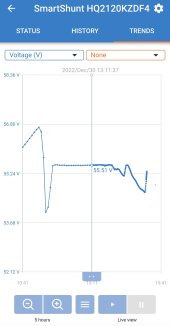
I think I'd call it a success with the SCC getting its instructions from the AIO via the cat5 connection.
Sadly, It did NOT ! So it appears that even in USER mode battery type, the software in this SCC will not work with my BMS and DIY battery that do not communicate with this SCC . In USER mode it's supposed to work, but in my case it does not.
With the SCC calibrated to battery voltage, Absorb voltage was set to 55.6v and it ran off to 56.7v before I shut it down. This was 3.54v per cell and I had every reason to believe the voltage would keep going up until the BMS shut charge down at the set 3.55v as it has done every other time for a month +.
So next I tried @shopman 's idea to directly connect the SCC together to the AIO via the RJ45 Jacks. Initial testing indicates this was a success. Every indication (on my limited array first charge with the new scc) seemed to indicate the scc was following the cut off voltage set in the AIO. And when I disconnected the cable the scc threw error code 63 (not connected to inverter). So it was communicating.
Using the Victron Smart Shunt I was able to captured both the charge that ran past the setting in the SCC, followed by enough discharge to start sending current again and the 2nd test with the SCC connected to the AIO. As you can see, (even with out the AIO connected to a solar input) the scc did NOT run up past 55.6v and stayed there until the sun started diminishing.

I think I'd call it a success with the SCC getting its instructions from the AIO via the cat5 connection.
Last edited:
MrM1
I'm Here, But I'm Not All There
My next test will be out at the farm with the full array connected to both the scc and AIO. I have every hope being connected to the AIO via cat5 is the solution.
Is it the 250Voc version of the sc48120 you are now getting to communicate? Unfortunately, there is no rj45 jack on my 150Voc version sc48120, only one usb typeA connection.My next test will be out at the farm with the full array connected to both the scc and AIO. I have every hope being connected to the AIO via cat5 is the solution.
MrM1
I'm Here, But I'm Not All There
250Voc version of the sc48120
MrM1
I'm Here, But I'm Not All There
Well ... it worked, until it didn't. Did the final install out at the off grid farm this week. The Growatt 12k inverter preformed as expected, but their Solar Charge Controller continues to be a headache. This thread has centered on Run Away voltage and how the SCC would stop sending current to the batteries, but the voltage just continued to rise until the batteries hit Over Voltage Protection in the BMS and stopped taking charge.
Well, yesterday, a new anomaly. Temps were such that the batteries charging was shut down via the BMS because of low temp protection. And I noticed the Growatt 12k was throwing a code [03]? What? Over Voltage shutdown on the inverter. Odd .
What was happening, was as the sun came out, the batteries were not taking charge due to the BMS, yet the voltage reading on the inverter was going, 56v, 57, 56, 58.9v 62v, 56v ... just bouncing all around quickly. As I investigated, I discovered, if I turned off the array connections going to the external SCC, this would stop. The internal SCC in the inverter worked fine, but the external Growatt SCC did not know what to do with the power and was not trying to stop it coming from the array. Throwing the inverter into over voltage disconnect. If I opened the charge for the batteries in the BMS ... problem solved, but in cold temps if the batteries temporarily stop allowing charge for protection ... the external SCC starts having fits.
Crazy
Ideas?
Well, yesterday, a new anomaly. Temps were such that the batteries charging was shut down via the BMS because of low temp protection. And I noticed the Growatt 12k was throwing a code [03]? What? Over Voltage shutdown on the inverter. Odd .
What was happening, was as the sun came out, the batteries were not taking charge due to the BMS, yet the voltage reading on the inverter was going, 56v, 57, 56, 58.9v 62v, 56v ... just bouncing all around quickly. As I investigated, I discovered, if I turned off the array connections going to the external SCC, this would stop. The internal SCC in the inverter worked fine, but the external Growatt SCC did not know what to do with the power and was not trying to stop it coming from the array. Throwing the inverter into over voltage disconnect. If I opened the charge for the batteries in the BMS ... problem solved, but in cold temps if the batteries temporarily stop allowing charge for protection ... the external SCC starts having fits.
Crazy
Ideas?
Apparently, I have an older version of the sc48120 150v non-mpv model. It only has the one usb port and a bts? plug on the side. No bms comms port. Went to adjust its voltage reading with Ian's software, and it would not connect. Doesn't even show there's anything on the other end of the usb cable. Also, the sc48120 menu only goes to setting #7, while the manual says there should be 15settings.
Does anyone have an older manual for this non-mpv model?
Found the older 150v non-mpv manual here older 150v gw sc48120 manual and apparently it only has 7 settings vs 15 of the newer model.
Does anyone have an older manual for this non-mpv model?
Found the older 150v non-mpv manual here older 150v gw sc48120 manual and apparently it only has 7 settings vs 15 of the newer model.
Last edited:
MrM1
I'm Here, But I'm Not All There
I'm probably going to have the newest version SC48120 for sale soon as I will not be able to communicate with DIY batteries and Heltec BMS
Czy ktoś znalazł samodzielne rozwiązanie problemu odcięcia ładowania LFP. Czy fabryka nie posiada najnowszego oprogramowania rozwiązującego ten problem?
PS
Czy wentylator w Twoim SCC pracuje na obrotach 0-1 i jest dość głośny? Podczas produkcji fotowoltaika włącza się co jakiś czas.
PS
Czy wentylator w Twoim SCC pracuje na obrotach 0-1 i jest dość głośny? Podczas produkcji fotowoltaika włącza się co jakiś czas.
Quattrohead
Solar Wizard
Has anyone found a solution to the LFP charging cutoff problem on their own? Doesn't the factory have the latest software to solve this problem?Czy ktoś znalazł samodzielne rozwiązanie problemu odcięcia ładowania LFP. Czy fabryka nie posiada najnowszego oprogramowania rozwiązującego ten problem?
PS
Czy wentylator w Twoim SCC pracuje na obrotach 0-1 i jest dość głośny? Podczas produkcji fotowoltaika włącza się co jakiś czas.
PS
Does the fan in your SCC run at 0-1 speed and is it quite loud? During production, the photovoltaics turn on from time to time.
Similar threads
- Replies
- 2
- Views
- 368
- Replies
- 5
- Views
- 538
- Replies
- 6
- Views
- 411
- Replies
- 14
- Views
- 524
- Replies
- 2
- Views
- 157



